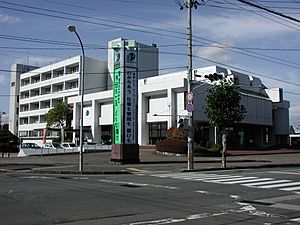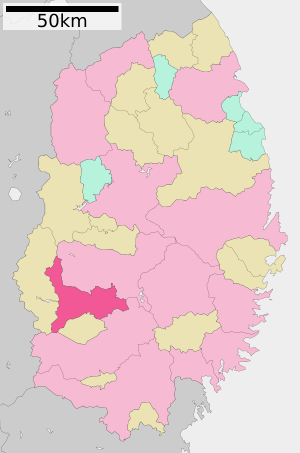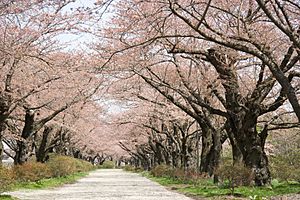Kitakami, Iwate facts for kids
Quick facts for kids
Kitakami
北上市
|
|||||||||||||
|---|---|---|---|---|---|---|---|---|---|---|---|---|---|

Kitakami City Hall
|
|||||||||||||
|
|||||||||||||

Location of Kitakami in Iwate Prefecture
|
|||||||||||||
| Country | Japan | ||||||||||||
| Region | Tōhoku | ||||||||||||
| Prefecture | Iwate | ||||||||||||
| Area | |||||||||||||
| • Total | 437.55 km2 (168.94 sq mi) | ||||||||||||
| Population
(February 1, 2023)
|
|||||||||||||
| • Total | 92,875 | ||||||||||||
| • Density | 212.261/km2 (549.755/sq mi) | ||||||||||||
| Time zone | UTC+9 (Japan Standard Time) | ||||||||||||
| Phone number | 0197-64-2111 | ||||||||||||
| Address | 1-1 Yoshi-cho, Kitakami-shi, Iwate-ken 024-8501 | ||||||||||||
| Climate | Cfa | ||||||||||||
|
|||||||||||||
Kitakami (北上市, Kitakami-shi) is a city in Iwate Prefecture, Japan. As of 2019, about 92,311 people lived there. The city covers an area of 437.55 square kilometers. Kitakami is famous for its beautiful sakura (cherry blossoms) that bloom in Tenshochi Park.
Contents
Geography and Location
Kitakami is in the southern part of Iwate Prefecture. It sits in the valley of the Kitakami River. The city is about 45 kilometers south of Morioka, which is the capital city of Iwate. It's also about 490 kilometers north of Tokyo.
The city is located where the Kitakami River and the Waga River meet. Its elevation ranges from 50 to 200 meters above sea level. In the eastern parts, it can rise to 400 meters.
Nearby Cities and Towns
Kitakami is surrounded by several other places in Iwate Prefecture:
- Hanamaki
- Ōshū
- Nishiwaga
- Kanegasaki
Climate in Kitakami
Kitakami has a humid subtropical climate. This means it has mild summers and cold winters. The average temperature each year is about 10.5°C (50.9°F). The city gets about 1319 mm (52 inches) of rain each year. September is usually the wettest month, and February is the driest.
The warmest month is August, with temperatures around 24.3°C (75.7°F). The coldest month is January, with temperatures around -2.4°C (27.7°F).
Population Changes
The number of people living in Kitakami has grown steadily for many decades. Recently, the population has stayed about the same.
| Historical population | ||
|---|---|---|
| Year | Pop. | ±% |
| 1920 | 43,431 | — |
| 1930 | 47,101 | +8.5% |
| 1940 | 52,622 | +11.7% |
| 1950 | 67,097 | +27.5% |
| 1960 | 70,032 | +4.4% |
| 1970 | 68,074 | −2.8% |
| 1980 | 76,633 | +12.6% |
| 1990 | 82,902 | +8.2% |
| 2000 | 91,501 | +10.4% |
| 2010 | 93,147 | +1.8% |
| 2020 | 93,045 | −0.1% |
History of Kitakami
The area where Kitakami is today has a very long history. It was part of an ancient region called Mutsu Province. People have lived here since at least the Jōmon period (an ancient time in Japanese history). The Emishi people were among the first settlers.
The area was once a stronghold for the Emishi leader Aterui. Later, during the Heian period (794-1185), the Abe clan ruled this region. It became a battlefield during the Former Nine Years War. After the Abe clan, the Northern Fujiwara clan took control.
During the Sengoku period (1467-1615), the Nanbu clan gained power. In the Edo period (1603-1868), most of the area belonged to Morioka Domain. This was under the rule of the Tokugawa shogunate, Japan's military government.
The modern town of Kurosawajiri was created on April 1, 1891. The current city of Kitakami was formed on April 1, 1954. This happened when Kurosawajiri merged with several villages. These villages included Iitoyo, Futako, Saraki, Oniyanai, Aisari, and Fukuoka. Later, on April 1, 1991, Kitakami grew even more. It absorbed the village of Ezuriko and the town of Waga.
City Government
Kitakami has a mayor-council government system. This means the city has a mayor who is directly elected by the people. There is also a city legislature, which has 13 members. This legislature is "unicameral," meaning it has only one group of lawmakers.
Kitakami and the nearby town of Nishiwaga together send four representatives to the Iwate Prefectural legislature. This is the government body for the entire Iwate Prefecture. For national politics, Kitakami is part of the Iwate 3rd district. This district elects a member to the House of Representatives of Japan, which is part of Japan's national parliament, the Diet of Japan.
Economy and Jobs
In the past, Kitakami's economy was mostly based on farming. However, the city has changed a lot. It's now easy to get to Sendai and Morioka using the Tōhoku Expressway. This has helped Kitakami become a center for light manufacturing and shipping goods. Many industrial parks have been built here, creating more jobs.
Education
Kitakami has many schools for young people. The city government runs 17 public elementary schools and nine public junior high schools. There are also five public high schools. These high schools are managed by the Iwate Prefectural Board of Education.
Getting Around Kitakami
Railway Lines
You can travel by train in Kitakami using the JR East lines.
- Tōhoku Shinkansen (bullet train): Kitakami
- Tōhoku Main Line: Kitakami - Murasakino
- Kitakami Line: Kitakami - Yanagihara - Ezuriko - Fujine - Tatekawame -Yokokawame - Iwasawa - Wakasennin
Highways
Major roads also connect Kitakami to other areas:
 Tōhoku Expressway – Kitakami-Kanegasaki IC, Kitakami-Ezuriko IC
Tōhoku Expressway – Kitakami-Kanegasaki IC, Kitakami-Ezuriko IC Akita Expressway – Kitakami IC, Kitakami-Nishi IC
Akita Expressway – Kitakami IC, Kitakami-Nishi IC National Route 4
National Route 4 National Route 107
National Route 107 National Route 456
National Route 456
Fun Things to See and Do
Kitakami has several interesting places to visit.
- Tenshochi Park: This park is famous for its beautiful sakura (cherry blossoms). It's considered one of the top 100 places in Japan to see these amazing flowers.
- Oni Kenbai (Devils Sword Dance): This is a traditional sword dance where performers dress up as demons. It's often performed during summer festivals, like the Kitakami Michinoku Traditional Dance Festival.
- Izumi Shikibu's Grave: Kitakami is also home to a site believed to be the grave of Izumi Shikibu. She was a very famous Heian period poet known for her waka poems.
Important Historical Sites
Several sites in Kitakami are recognized as National Historic Sites of Japan:
- Kabayama Site: These are ruins from the Jōmon period.
- Ezuriko Kofun Cluster: This is a group of ancient burial mounds from the Kofun period.
- Kunimisan temple ruins: These are the ruins of a temple from the Heian period.
- Hatten Site: More ruins from a Jōmon period settlement.
- Nanbu-Date border mounds: These are markers from the Edo period that showed the border between different regions.
International Connections
Kitakami has special relationships with cities in other countries:
 USA – Concord, California, United States: They have been sister cities since October 25, 1974.
USA – Concord, California, United States: They have been sister cities since October 25, 1974. China – Sanmenxia, Henan Province, China: They became friendship cities on May 25, 1985.
China – Sanmenxia, Henan Province, China: They became friendship cities on May 25, 1985.
Famous People from Kitakami
Many notable people come from Kitakami, including:
- Tamaki Saitō, a psychologist
- Hiroki Suzuki, an actor
- Saori Takahashi, a professional women's volleyball player
- Tatsuo Hirano, a politician
- Yoshiaki Fujiwara, a professional wrestler
- Akira Yaegashi, a professional boxer
- Yoshida Tatsuya, a musician
See also
 In Spanish: Kitakami (Iwate) para niños
In Spanish: Kitakami (Iwate) para niños





